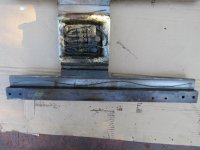Zahnrad Kopf
Diamond
- Joined
- Apr 5, 2010
- Location
- Tropic of Milwaukee
I am trying not to be alarmist, given all the other stuff I am working on with this machine. So, please tell me that 10EE saddles are made like this on purpose.
Please? Pretty please? With a cherry on top?
The area of concern is directly in front of, and behind the web that connects the front to the rear. The bearing surface area. Consisting of approximately 5" or 6" in width. This area is extremely noticeably lower ( higher ? ) than the rest of the ways. probably somewhere in the order of .040". See pictures. It is the dark area on the rear section, and on the front section one can make out the bright spot that is basically like a large chamfer, leading into the relieved area. It is directly in line with the rear one, in width.




Please? Pretty please? With a cherry on top?
The area of concern is directly in front of, and behind the web that connects the front to the rear. The bearing surface area. Consisting of approximately 5" or 6" in width. This area is extremely noticeably lower ( higher ? ) than the rest of the ways. probably somewhere in the order of .040". See pictures. It is the dark area on the rear section, and on the front section one can make out the bright spot that is basically like a large chamfer, leading into the relieved area. It is directly in line with the rear one, in width.








 Lemme check my Connelly's on that. Where is Richard King? Look at OKBill's saddle in his thread, I see no relief like that on his , and it looks like a relatively? low hours machine. This looks like somebody's fix.
Lemme check my Connelly's on that. Where is Richard King? Look at OKBill's saddle in his thread, I see no relief like that on his , and it looks like a relatively? low hours machine. This looks like somebody's fix.









 JMO
JMO